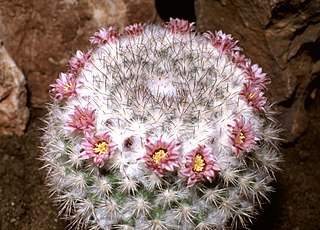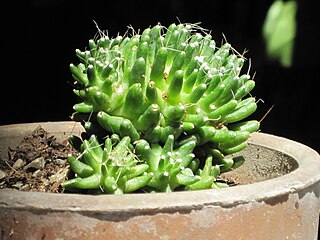
Mammillaria is one of the largest genera in the cactus family (Cactaceae), with currently 200 known species and varieties recognized. Most of the mammillaria are native to Mexico, but some come from the southwest United States, the Caribbean, Colombia, Venezuela, Guatemala and Honduras. The common name "pincushion cactus" refers to this and the closely related genus Escobaria.

Kroenleinia grusonii, popularly known as the golden barrel cactus, golden ball or mother-in-law's cushion, is a species of barrel cactus which is endemic to east-central Mexico.

Astrophytum capricorne, the goat's horn cactus, is a species of flowering plant in the cactus family Cactaceae, that is native to the Coahuila regions of Northern Mexico. Growing to 50 centimetres (20 in) tall by 10 centimetres (3.9 in) wide in a ball or oval shape, it is grey-green in colour with 7 to 9 prominent ribs, very long twisted spines and yellow flowers with a red centre in summer.

Astrophytum asterias is a species of cactus in the genus Astrophytum, and is native to small parts of Texas in the United States and Mexico. Common names include sand dollar cactus, sea urchin cactus, star cactus and star peyote.

Cochemiea guelzowiana is a species of plant in the family Cactaceae. The species epithet guelzowiana honors the German cactus collector Robert Gülzow of Berlín.

Mammillaria guillauminiana is a species of plant in the family Cactaceae.

Mammillaria painteri is a species of plant in the family Cactaceae. It is endemic to Mexico. It is usually found near, but not limited to, San Juan del Rio, Guanajuato. It is commonly referred to as the biznaguita in Spanish. It is also known by many to be synonymous with Mammillaria crinita subspecies crinita. It was evaluated and added to the IUCN Redlist in 2002 as data deficient. The causes of this species' endangerment or threats to its well-being are not clear.

Mammillaria zeilmanniana is a species of cactus. It is endemic to Mexico, where it is known only from Guanajuato. It grows in a narrow canyon usually near water where there is high humidity, its total population is fewer than 250 individuals. It is threatened by illegal collection for the horticultural trade. Recent studies link this species to Mammillaria crinita.

Rhipsalis pilocarpa, the hairy-fruited wickerware cactus, is a species of flowering plant in the cactus family that is endemic to Brazil. Scarce in the wild, it is known only in a small number of isolated locations. Its status is listed as “vulnerable” by the IUCN Red List. However, it is cultivated as an ornamental houseplant and as such has gained the Royal Horticultural Society’s Award of Garden Merit.

Turbinicarpus pseudopectinatus is a species of plant in the family Cactaceae.

Mammillaria spinosissima, also known as the spiny pincushion cactus, is a species of flowering plant in the cactus family Cactaceae, endemic to the central Mexican states of Guerrero and Morelos, where they grow at elevations of approximately 1,600 to 1,900 metres. The species was described in 1838 by James Forbes, gardener of the Duke of Bedford. Botanist David Hunt collected a specimen in 1971, when he located one near Sierra de Tepoztlan, Mexico.

Mammillaria magnimamma, common name Mexican pincushion, is a species of flowering plant in the cactus family Cactaceae.

Mammillaria bombycina, the silken pincushion cactus, is a species of flowering plant in the family Cactaceae.

Mammillaria hahniana, the old lady cactus, is a species of flowering plant in the family Cactaceae, native to central Mexico. It grows to 25 cm (10 in) tall by 50 cm (20 in) broad. The solitary spherical stems, 12 cm in diameter, are covered in white down and white spines. Reddish purple flowers are borne in spring and summer, sometimes forming a complete ring around the apex of the plant.

Mammillaria plumosa, the feather cactus, is a species of flowering plant in the family Cactaceae, native to Northeastern Mexico.

Mammillaria glassii is a species of cactus in the subfamily Cactoideae. It is a small, clumping cactus with "fluffy white spines." M. glassii is native to Mexico in the states of Coahuila and Nuevo León.

Mammillaria fraileana is one of about 200 species of the genus Mammillaria from the cactus family Cactaceae. This species is native to Mexico and can be found along the east coast of the southern part of Baja California Peninsula in Desert Scrub communities. They tend to grow in non-calcareous dry granite-based soil but can also grow in rocky habitats, either in rock fissures or directly on top of the rock surface even without the presence of soil. Thus, the mineral composition of the rocks in their habitat directly influence their abundance. The habitat of Mammillaria fraileana is home to succulent flora and is particularly rich in local endemics. Currently, no major threats to the species are known to exist.

Mammillaria surculosa is a species of flowering plant in the cactus family Cactaceae, native to north eastern Mexico, where it occurs in extremely isolated patches at altitudes of 950–1,200 m (3,120–3,940 ft). It is registered as “Endangered” by the IUCN Red List. Growing to 10 cm (3.9 in) tall by 50 cm (20 in) wide, this tiny plant forms colonies of spiny stems with relatively large, lemon yellow flowers in spring.

Mammillaria sphaerica, the longmamma nipple cactus or pale mammillaria is a species of flowering plant in the cactus family Cactaceae, native to south eastern Texas in the USA and north eastern Mexico, where it occurs in scattered patches at altitudes up to 1,000 m (3,300 ft). It forms clumps of small pale green spheres to 5 cm (2.0 in) in diameter, with short hairs and pale yellow flowers up to 3 cm (1.2 in) wide in summer.

Mammillaria laui is a species of cactus in the genus Mammillaria, native to Tamaulipas state in Mexico. A number of subspecies were described, occurring along an elevation gradient; these are no longer accepted. It is listed as Critically Endangered (CR) in the wild. As Mammillaria lauii it has gained the Royal Horticultural Society's Award of Garden Merit.





















